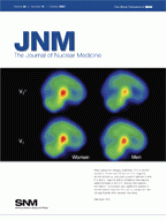TO THE EDITOR:We read the article by Moy et al. (1) with great interest. This is one of the few studies that have investigated the role of PET/MRI in evaluating primary breast cancer. Several investigators have assessed the role of 18F-FDG PET in the comprehensive detection of primary breast cancer and found encouraging results (2,3). The initial PET studies were done on smaller numbers of patients and with larger primary breast tumors. However, recent studies on small breast tumors have demonstrated a relatively lower diagnostic accuracy for PET. Because of the limitations of PET alone, the most popular area of research in recent years has been the role of combined PET and CT or MRI. The combination of PET with CT or MRI provides the best of 2 modalities; that is, PET reveals the functional status while CT or MRI reveals structural details in the same sitting. We want to emphasize that, in breast cancer imaging, PET alone and PET fusion with CT or MRI have a significant false-negative rate that must be considered before they are used as a screening modality and the patient potentially subjected to expensive and time-consuming tests.
Fusion of a functional imaging modality such as PET, which has high specificity, with a structural modality such as MRI, which has high sensitivity, should give us results with both high sensitivity and high specificity. Stadnik et al. (3) compared MRI and 18F-FDG PET in staging breast cancer and imaging axillary lymph nodes in 10 patients and found the sensitivity and specificity to be 100% and 80%, respectively, for MRI and 80% and 100%, respectively, for PET (3). The combination of MRI and 18F-FDG PET achieved 100% sensitivity and specificity. Thus, they concluded that the combined method had the potential to identify which patients should undergo axillary dissection versus which should undergo sentinel node lymphadenectomy. In contrast, Moy et al. (1) noted a sensitivity and specificity of 92% and 52%, respectively, for MRI alone and 63% and 95%, respectively, for PET/MRI. The high specificity of PET/MRI can help define the subset of patients that surely should undergo tissue diagnosis of the suggestive lesions. However, because of the high false-negativity of PET/MRI, there would still be an additional subset of patients who require histologic examination of the lesion to rule out cancer. In the study of Moy et al., ductal carcinoma in situ consistently showed lower 18F-FDG uptake (standardized uptake value [SUV] < 2), except in one patient (patient 21). It is interesting to note that patient 17, with a 9-cm ductal carcinoma in situ, had an SUV of 0.4 whereas patient 21, with a 2-cm ductal carcinoma in situ, had an SUV of 3.2. All invasive ductal carcinoma lesions with poor differentiation had SUVs of less than 2.5. A patient with moderately differentiated invasive ductal carcinoma and invasive lobular carcinoma, and other patients with smaller tumors ranging from 0.9 to 1.1 cm, had SUVs of less than 2.5. These results concur with already published data showing a higher tendency toward false-negativity for lesions from carcinoma in situ and for low-grade, well-differentiated, or lobular carcinomas.
Several studies have reported excellent sensitivity and specificity for PET in breast cancer (2,4). However, data on the detection of smaller lesions using PET are limited. In our study on 111 patients with suspected breast cancer (5), 18F-FDG PET alone had a sensitivity of 48%, a specificity of 97%, a positive predictive value of 98%, a negative predictive value of 40%, and an accuracy of 61%. In that study, we found a sensitivity of only 23% (7/30) for primary breast cancer lesions that were 10 mm or smaller. This finding has 2 potential explanations. One is that lower SUVs are greatly affected by partial-volume effects in smaller tumors because the counts are spread over a larger area. Another is that smaller lesions have lower SUVs because metabolic activity may increase with tumor growth. In one study, correction for partial-volume effect improved sensitivity from 75% to 92% while decreasing specificity from 100% to 97% (6). In our study, we did not find the significant correlation between tumor type and false-negative PET results that was found by other investigators (5,7). Another study found that invasive ductal carcinomas had significantly higher 18F-FDG uptake than did lobular carcinomas (SUV, 3.7 ± 2.2 vs. 2.1 ± 1.4, P = 0.003); thus, lobular cancers might be another factor leading to false-negative reports. The lower SUVs in lobular cancers might be explained by a lower tumor cell density and by diffuse surrounding tissue infiltration. A significantly positive correlation was found with the pattern of microscopic tumor growth (nodular vs. diffuse); thus, diffuse tumors might also be missed, causing false-negative results (7).
In conclusion, the clinical application of PET/MRI as an initial screening test may prove limited by the significant number of false-negative results. More randomized controlled studies using PET/CT or PET/MRI on patients with smaller breast lesions are required to establish the exact role of combined functional and structural modalities in this type of cancer.
Footnotes
-
COPYRIGHT © 2007 by the Society of Nuclear Medicine, Inc.







